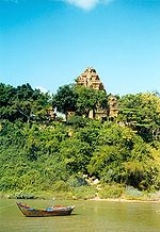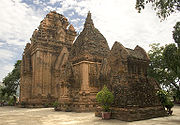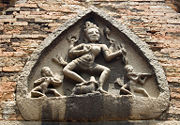
Po nagar
Encyclopedia
Po Nagar is a Cham
temple tower founded sometime before 781 AD and located in the medieval principality of Kauthara, near modern Nha Trang
in Vietnam
. It is dedicated to Yan Po Nagar
, the goddess of the country, who came to be identified with the Hindu
goddesses Bhagavati and Mahishasuramardini, and who in Vietnamese is called Thiên Y Thánh Mâu.
dated 781
AD indicates that the Cham King Satyavarman regained power in the area of "Ha-Ra Bridge", and that he restored the devastated temple. From this inscription can be deduced that the area previously had come under temporary foreign dominion, and that foreign vandals had damaged the already existing temple. Other steles indicate that the temple had contained a mukhalinga
decorated with jewelry and resembling an angel's head. Foreign robbers, perhaps from Java
, "men living on food more horrible than cadavers, frightful, completely black and gaunt, dreadful and evil as death" had arrived in ships, had stolen the jewelry and had broken the linga. Though the king had chased the robbers out to sea, the treasure had been lost forever. The steles also indicate that the king restored the linga in 784 AD.
A stele
dated 918
AD by the Cham King Indravarman III states an order to build a golden statue to the goddess Bhagavati. Later steles report that the original statue was stolen by the Khmer
, and that in 965
AD, the king replaced the lost statue with a new one. A stele dated 1050 AD says that offerings of fields, of slaves, of jewelry and of precious metals were made to the statue. Later steles indicate the celebration of a cult in honor of the goddess Yan Po Nagar, as well as the presence of statues dedicated to the principal deities of Hinduism
and Buddhism
.
In the 17th century, the Viet people occupied Champa and took over the temple tower, calling it Thiên Y Thánh Mâu Tower. A number of Vietnamese legends regarding the goddess and the tower have come into being.
 The Po Nagar complex is situated on Cù Lao Mountain. It consists of three levels, the highest of which encompasses two rows of towers. The main tower is about 25 m high.
The Po Nagar complex is situated on Cù Lao Mountain. It consists of three levels, the highest of which encompasses two rows of towers. The main tower is about 25 m high.
 The temple's central image is a 1.2m tall stone statue of the goddess Yan Po Nagar sitting cross-legged, dressed only in a skirt, with ten hands holding various symbolic items. According to Vietnamese scholar Ngô Vǎn Doanh, these attributes show that Yan Po Nagar was identified also with the Hindu
The temple's central image is a 1.2m tall stone statue of the goddess Yan Po Nagar sitting cross-legged, dressed only in a skirt, with ten hands holding various symbolic items. According to Vietnamese scholar Ngô Vǎn Doanh, these attributes show that Yan Po Nagar was identified also with the Hindu
goddess Mahishasuramardini or Durga
, the slayer of the buffalo-demon. Another sculpture of the goddess as Mahishasuramardini may be found in the pediment
above the entrance to the temple: it depicts the four-armed goddess holding a hatchet, a lotus and a club, and standing on a buffalo. This sculpture belongs to the Tra Kieu
style of Cham art from the end of the 10th century or the beginning of the 11th century AD.
Champa
The kingdom of Champa was an Indianized kingdom that controlled what is now southern and central Vietnam from approximately the 7th century through to 1832.The Cham people are remnants...
temple tower founded sometime before 781 AD and located in the medieval principality of Kauthara, near modern Nha Trang
Nha Trang
Nha Trang is a coastal city and capital of Khanh Hoa province, on the South Central Coast of Vietnam. It is bounded on the North by Ninh Hoà district, on the East by the South China Sea, on the South by Cam Ranh town and on the West by Diên Khánh district...
in Vietnam
Vietnam
Vietnam – sometimes spelled Viet Nam , officially the Socialist Republic of Vietnam – is the easternmost country on the Indochina Peninsula in Southeast Asia. It is bordered by China to the north, Laos to the northwest, Cambodia to the southwest, and the South China Sea –...
. It is dedicated to Yan Po Nagar
Lady Po Nagar
According to Cham legend, Lady Po Nagar, or Leiou Ye, was the founder of the Cham nation. She originated from Khanh Hoa province, in a peasant family in the mountains of Dai An...
, the goddess of the country, who came to be identified with the Hindu
Hindu
Hindu refers to an identity associated with the philosophical, religious and cultural systems that are indigenous to the Indian subcontinent. As used in the Constitution of India, the word "Hindu" is also attributed to all persons professing any Indian religion...
goddesses Bhagavati and Mahishasuramardini, and who in Vietnamese is called Thiên Y Thánh Mâu.
History
A steleStele
A stele , also stela , is a stone or wooden slab, generally taller than it is wide, erected for funerals or commemorative purposes, most usually decorated with the names and titles of the deceased or living — inscribed, carved in relief , or painted onto the slab...
dated 781
781
Year 781 was a common year starting on Monday of the Julian calendar. The denomination 781 for this year has been used since the early medieval period, when the Anno Domini calendar era became the prevalent method in Europe for naming years.- Asia :* July 31 – The oldest recorded eruption...
AD indicates that the Cham King Satyavarman regained power in the area of "Ha-Ra Bridge", and that he restored the devastated temple. From this inscription can be deduced that the area previously had come under temporary foreign dominion, and that foreign vandals had damaged the already existing temple. Other steles indicate that the temple had contained a mukhalinga
Architecture of Cambodia
The period of Angkor is the period from approximately the latter half of the 8th century AD to the first half of the 15th century. If precise dates are required, the beginning may be set in 802 AD, when the founder of the Khmer Empire , Jayavarman II pronounced himself universal monarch and...
decorated with jewelry and resembling an angel's head. Foreign robbers, perhaps from Java
Java
Java is an island of Indonesia. With a population of 135 million , it is the world's most populous island, and one of the most densely populated regions in the world. It is home to 60% of Indonesia's population. The Indonesian capital city, Jakarta, is in west Java...
, "men living on food more horrible than cadavers, frightful, completely black and gaunt, dreadful and evil as death" had arrived in ships, had stolen the jewelry and had broken the linga. Though the king had chased the robbers out to sea, the treasure had been lost forever. The steles also indicate that the king restored the linga in 784 AD.
A stele
Stele
A stele , also stela , is a stone or wooden slab, generally taller than it is wide, erected for funerals or commemorative purposes, most usually decorated with the names and titles of the deceased or living — inscribed, carved in relief , or painted onto the slab...
dated 918
918
Year 918 was a common year starting on Thursday of the Julian calendar.- Asia :* Taebong has been overthrown, and Goryeo established in the Korean peninsula, when Wang Kon ascends the throne at Cheorwon.* The Khitan empire's government occupies a newly walled capital city called Shangjing,...
AD by the Cham King Indravarman III states an order to build a golden statue to the goddess Bhagavati. Later steles report that the original statue was stolen by the Khmer
Khmer people
Khmer people are the predominant ethnic group in Cambodia, accounting for approximately 90% of the 14.8 million people in the country. They speak the Khmer language, which is part of the larger Mon–Khmer language family found throughout Southeast Asia...
, and that in 965
965
Year 965 was a common year starting on Sunday of the Julian calendar.- Europe :* The Khazar fortress of Sarkel falls to the Kievan Rus....
AD, the king replaced the lost statue with a new one. A stele dated 1050 AD says that offerings of fields, of slaves, of jewelry and of precious metals were made to the statue. Later steles indicate the celebration of a cult in honor of the goddess Yan Po Nagar, as well as the presence of statues dedicated to the principal deities of Hinduism
Hinduism
Hinduism is the predominant and indigenous religious tradition of the Indian Subcontinent. Hinduism is known to its followers as , amongst many other expressions...
and Buddhism
Buddhism
Buddhism is a religion and philosophy encompassing a variety of traditions, beliefs and practices, largely based on teachings attributed to Siddhartha Gautama, commonly known as the Buddha . The Buddha lived and taught in the northeastern Indian subcontinent some time between the 6th and 4th...
.
In the 17th century, the Viet people occupied Champa and took over the temple tower, calling it Thiên Y Thánh Mâu Tower. A number of Vietnamese legends regarding the goddess and the tower have come into being.
Site


Hindu
Hindu refers to an identity associated with the philosophical, religious and cultural systems that are indigenous to the Indian subcontinent. As used in the Constitution of India, the word "Hindu" is also attributed to all persons professing any Indian religion...
goddess Mahishasuramardini or Durga
Durga
For the 1985 Hindi Film of Rajesh Khanna see DurgaaIn Hinduism, Durga ; ; meaning "the inaccessible" or "the invincible"; , durga) or Maa Durga "one who can redeem in situations of utmost distress" is a form of Devi, the supremely radiant goddess, depicted as having eighteen arms, riding a lion...
, the slayer of the buffalo-demon. Another sculpture of the goddess as Mahishasuramardini may be found in the pediment
Pediment
A pediment is a classical architectural element consisting of the triangular section found above the horizontal structure , typically supported by columns. The gable end of the pediment is surrounded by the cornice moulding...
above the entrance to the temple: it depicts the four-armed goddess holding a hatchet, a lotus and a club, and standing on a buffalo. This sculpture belongs to the Tra Kieu
Art of Champa
Champa was an Indic civilization that flourished along the coasts of what is now central and southern Vietnam for roughly a one thousand year period between 500 AD and 1500 AD. The original Chams were probably colonists from the Indonesian islands, who adopted as their principal vocations those of...
style of Cham art from the end of the 10th century or the beginning of the 11th century AD.

